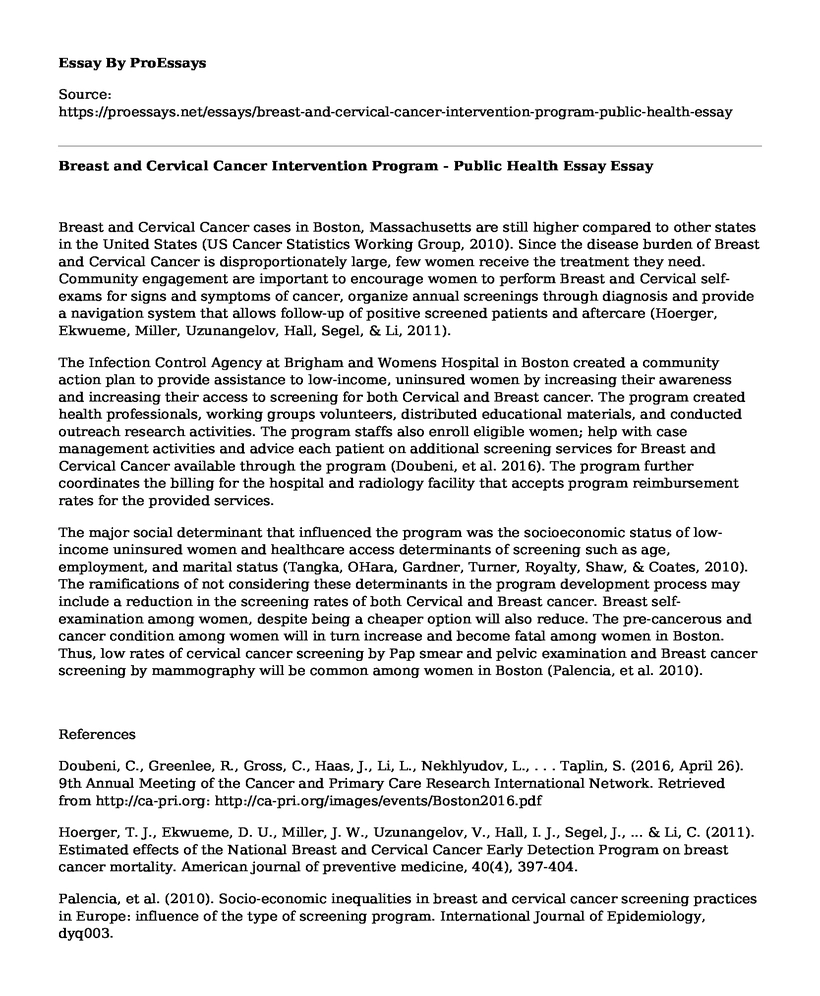Breast and Cervical Cancer cases in Boston, Massachusetts are still higher compared to other states in the United States (US Cancer Statistics Working Group, 2010). Since the disease burden of Breast and Cervical Cancer is disproportionately large, few women receive the treatment they need. Community engagement are important to encourage women to perform Breast and Cervical self-exams for signs and symptoms of cancer, organize annual screenings through diagnosis and provide a navigation system that allows follow-up of positive screened patients and aftercare (Hoerger, Ekwueme, Miller, Uzunangelov, Hall, Segel, & Li, 2011).
The Infection Control Agency at Brigham and Womens Hospital in Boston created a community action plan to provide assistance to low-income, uninsured women by increasing their awareness and increasing their access to screening for both Cervical and Breast cancer. The program created health professionals, working groups volunteers, distributed educational materials, and conducted outreach research activities. The program staffs also enroll eligible women; help with case management activities and advice each patient on additional screening services for Breast and Cervical Cancer available through the program (Doubeni, et al. 2016). The program further coordinates the billing for the hospital and radiology facility that accepts program reimbursement rates for the provided services.
The major social determinant that influenced the program was the socioeconomic status of low-income uninsured women and healthcare access determinants of screening such as age, employment, and marital status (Tangka, OHara, Gardner, Turner, Royalty, Shaw, & Coates, 2010). The ramifications of not considering these determinants in the program development process may include a reduction in the screening rates of both Cervical and Breast cancer. Breast self-examination among women, despite being a cheaper option will also reduce. The pre-cancerous and cancer condition among women will in turn increase and become fatal among women in Boston. Thus, low rates of cervical cancer screening by Pap smear and pelvic examination and Breast cancer screening by mammography will be common among women in Boston (Palencia, et al. 2010).
References
Doubeni, C., Greenlee, R., Gross, C., Haas, J., Li, L., Nekhlyudov, L., . . . Taplin, S. (2016, April 26). 9th Annual Meeting of the Cancer and Primary Care Research International Network. Retrieved from http://ca-pri.org: http://ca-pri.org/images/events/Boston2016.pdf
Hoerger, T. J., Ekwueme, D. U., Miller, J. W., Uzunangelov, V., Hall, I. J., Segel, J., ... & Li, C. (2011). Estimated effects of the National Breast and Cervical Cancer Early Detection Program on breast cancer mortality. American journal of preventive medicine, 40(4), 397-404.
Palencia, et al. (2010). Socio-economic inequalities in breast and cervical cancer screening practices in Europe: influence of the type of screening program. International Journal of Epidemiology, dyq003.
Tangka, F. K., OHara, B., Gardner, J. G., Turner, J., Royalty, J., Shaw, K., ... & Coates, R. J. (2010). Meeting the cervical cancer screening needs of underserved women: the National Breast and Cervical Cancer Early Detection Program, 20042006. Cancer Causes & Control, 21(7), 1081-1090.
US Cancer Statistics Working Group. (2010). United States cancer statistics: 19992006 incidence and mortality web-based report. Atlanta: US Department of Health and Human Services, Centers for Disease Control and Prevention and National Cancer Institute.
Cite this page
Breast and Cervical Cancer Intervention Program - Public Health Essay. (2021, Jun 24). Retrieved from https://proessays.net/essays/breast-and-cervical-cancer-intervention-program-public-health-essay
If you are the original author of this essay and no longer wish to have it published on the ProEssays website, please click below to request its removal:
- Course Work Example: Definition and Scope of Practice of Advanced Practice Registered Nurses
- Prevention of Workplace Violence Essay Example
- Imposters in Healthcare Essay Example
- Quality Indicators: Nursing & Patient Care Impact - Essay Sample
- Paper Example on COVID-19 Pandemic: Examining National Policies in America
- Free Essay Example on Getting Back on Your Feet: Post-Illness Advice from a Patient
- Report Example on Barcode Medication Administration







